“Those early years in France were among the best of my life. They marked a crucial period of transformation in which I found my true calling, experienced an awakening of the senses, and had such fun that I hardly stopped moving long enough to catch my breath.” ~Julia Child (My Life in France, Knopf, 2006).
OOH-LA-LA and MIAO!
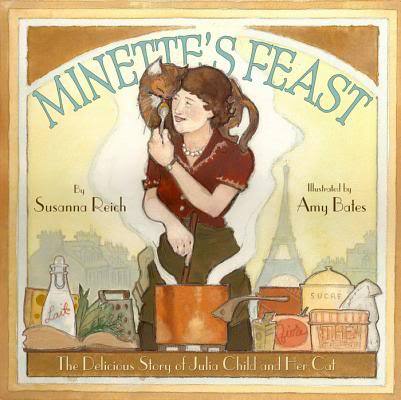
We’ve set out our best red-and-white checked tablecloth today in honor of special guests Susanna Reich and Amy Bates, co-creators of the delectably enchanting picture book biography, Minette’s Feast: The Delicious Story of Julia Child and Her Cat (Abrams, 2012)!
*purrrrrs*
Shortly after Julia and her husband Paul moved to Paris in 1948, they were adopted by “a mischievous, energetic poussiequette with a lovely speckled coat,” whom they named Minette Mimosa McWilliams Child. This sly, feisty feline instantly charmed her way into their hearts and became an important part of their lives, sitting on Paul’s lap during meals and stealing tidbits off his plate when she thought he wasn’t looking.
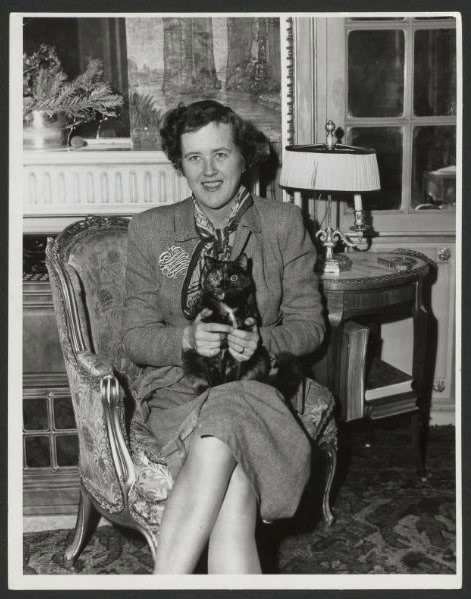
In Minette’s Feast, we are treated to a scrumptious snapshot from those glorious, golden, transformational years of Julia’s culinary awakening through the eyes of her very first cat, who, as this story goes, adamantly preferred fresh mouse or bird to any of the future Queen of Cuisine’s offerings.
Day and night, the “luckiest cat in all of Paris . . . could smell the delicious smells of mayonnaise, hollandaise, cassoulets, cheese soufflés and duck pâtés.” C’est magnifique!
But whether Julia prepared something specially for Minette (fish heads with chicken liver custard), or presented her with tasty scraps from the day’s culinary experiments, for ravenous Mini, “there would always be mouse.”
*licks chops*
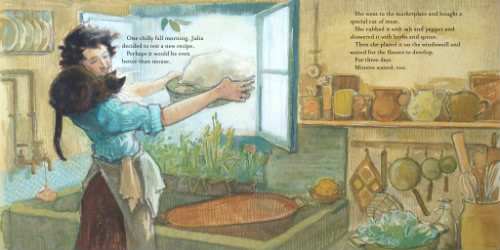
Susanna, with her perfectly seasoned, lyrical text (“she baked and blanched, blended and boiled, drained and dried, dusted and fried”), and Amy, with her cozy-warm, evocative pencil and watercolor illos, have beautifully captured Julia’s energy and zeal, Minette’s pampered puss impishness, Paul and Julia’s mutual affection, and the romantic ambiance of late 40’s Paris.


The book has been showered with accolades, including four *starred reviews* from Kirkus, Booklist, School Library Journal and Shelf Awareness, as well as a Rave from Horn Book, who said, “Reich has a storyteller’s instinct for entrancing incident and a poet’s gift for sound and sensory detail,” and, “The roofs and markets of Paris and Julia’s busy kitchen all spring to life in a pleasing palette keyed to both fresh food and tortoiseshell cat: chocolate-brown, buttery-yellow, and coppery-red are nicely countered by soft blues and lettuce-green hues.”
In a word,YUM!!
Both Susanna and Amy enjoy cooking and point to Julia as inspiration. We thank them heartily for visiting today — they’re sharing photos, favorite recipes, and a few tasty tidbits about working on this cleverly conceived and masterfully executed picture book gem. No doubt Julia would have loved it!
* * *
♥ WHISKERS FOR DINNER ♥

I imagine it was wonderful, delicious fun researching this book. Can you share a few interesting or surprising things about Julia the average person might not know?
Susanna: People know that Julia was tall, but they don’t always realize just how tall—six foot two! Her sister Dorothy was six foot four, and her brother John was also more than six feet tall. Their mother used to say she grew 18 feet of children.
Julia probably got her playful sense of humor from her mother (her father she describes as taciturn and reserved). But she certainly didn’t learn to cook at her mother’s knee. Julia once said her mother could make only three dishes—baking powder biscuits, Welsh rarebit, and deep-fried Codfish balls.
Amy: I was impressed with what a real person she seemed to be. So many people have a false veneer of niceness. She radiates authenticity.
Of interest to me as an illustrator, I found out that all the illustrations in Mastering the Art of French Cooking were illustrated by Sidonie Coryn. The illustrations were made from photos that Paul Child took of Julia Child’s hands. So all the hands in the book are Julia’s hands. I like that.
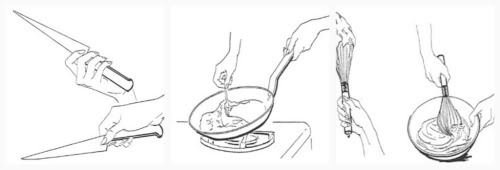

If you’ve used Mastering the Art of French Cooking, what are some of your favorite recipes? Which have been the most challenging? Any disasters or pleasant surprises?
Susanna: Mastering the Art of French Cooking is a classic because the recipes are both very detailed and easy to follow. Julia breaks everything down and explains it all step-by-step. Her recipes for all the different kinds of French sauces are invaluable, for example.
My favorite dish is Coq Au Vin (Chicken In Red Wine, Vol. 1, p. 263). The step where you light the cognac on fire is a little scary. I almost singed my eyebrows off the last time I made it. Make sure you follow the instructions to avert your face! I’m also fond of Potages Aux Concombres (Cream of Cucumber Soup, Vol. 2, p. 17). It’s really easy to make and can be served hot or cold. I always serve it cold in the summertime.
Amy: Oh! Disasters a plenty. I have three young children who love to help and add all kinds of ingredients when I am not looking. After all, a little vanilla and sugar is good, so why not add a lot to make it better?
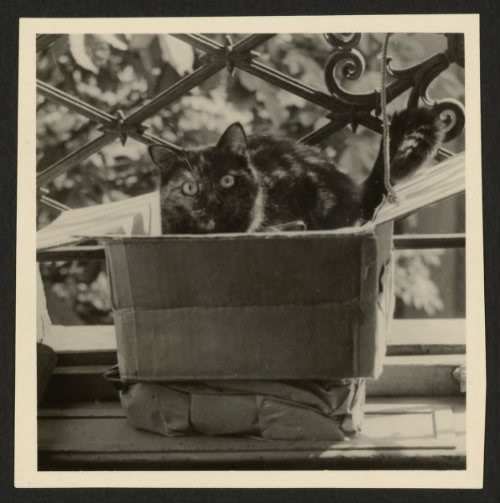
So many of us grew up watching “The French Chef.” Did this series spark your interest in cooking when you were little? How has Julia influenced your overall approach to cooking and entertaining through the years?
Susanna: As a child, I loved watching “The French Chef.” Julia made cooking—and eating—look like so much fun. When I entertain, I especially appreciate her admonition never to apologize for what you’re serving. I admire her confidence.
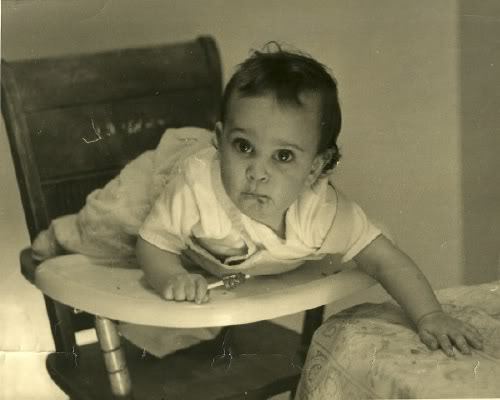
Amy: I used to watch it with my Grandma. I think at the time I thought she was funny, rather than it making me want to cook. I really came into an enjoyment of cooking quite a bit later.
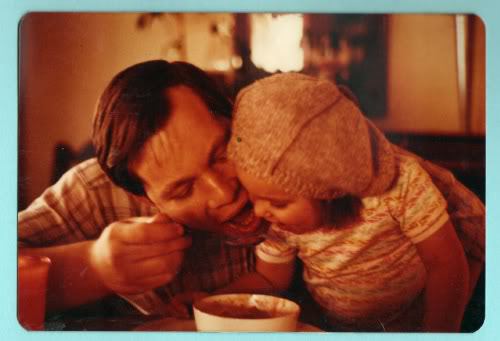
Susanna, what do you like most about Amy’s visual interpretation of your text? What’s your favorite spread from the book and why?
I love Amy’s illustrations and was thrilled to be shown sketches early on so that we could confer about historical accuracy. What I love best is the way she captures the characters’ emotions and relationships. My favorite spread is the one with Julia and Paul standing in front of their apartment building. On the right-hand page, Julia cradles Minette in her arms while Paul chucks her under the chin, and on the opposite page there are two pigeons perched on a windowsill. The figures of Julia and Paul are so expressive, and the pigeons give the spread a visual and psychological balance. You can practically hear the cooing coming from both the people and pigeons. And the colors—soft blues and greens against the creamy background of the building—are just beautiful.

Amy, what’s your favorite spread? How did you create it? What’s your favorite part of the illustration process?
The one that shows four of her working in the kitchen while Minette is still the whole time watching the mouse. I don’t know which is my favorite. This one that seems most applicable right here. I like the kitchen. I spent quite a bit of time trying to piece her kitchen together just the way it would have been, warts and all. I looked at tons of pictures. I feel pretty good about it.
I like the initial excitement of laying down sketches and working with the text and interpreting the text. Trying to pull out the visual story.

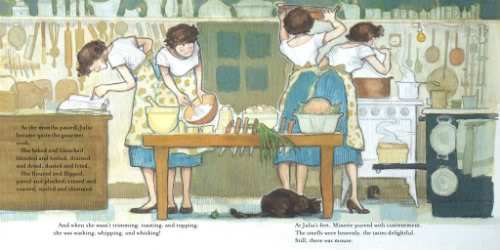

What do you hope young readers will take away from Minette’s Feast?
Susanna: Julia Child is a marvelous role model. I’d like readers to come away with an understanding of some of the qualities we admire most about her—her dedication to excellence, her prodigious energy, her down-to-earth sense of humor, her passion for cooking, her joie de vivre. I’m also glad to be sharing two less well-known aspects of her life: her close partnership with her husband Paul, and her love of cats.
Amy: I hope they get carried away to Paris in the 1940s. I hope they are intrigued by Julia Child and her cat and see someone making a home for themselves as well as finding something that they love to do. And you can do that when you are 7 or 37.

Why do you think Julia and her cookbooks are more popular than ever, despite the fact that we are a rushed, fast-food, instant-everything microwave society? If you could see her today, what would you ask her?
Susanna: Julia thought of herself as a teacher more than anything else, and what a wonderful teacher she was. Long before there were farmers’ markets in every major city, she stressed the importance of fresh, quality ingredients and good, basic cooking techniques. These are ideas that can be applied to every type of cuisine. Let’s not forget she was also a bit of a ham, and understood how to entertain her audience while delivering solid information. If I were to meet her today, I think I would just try to get to know her better. I’d ask about her cats.
Amy: I think you might have answered your own question! I feel the more fast pace life gets, the more I am intrigued by a simpler time. It is easy to idealize the past as being a more perfect time. Though obviously we know that isn’t true.
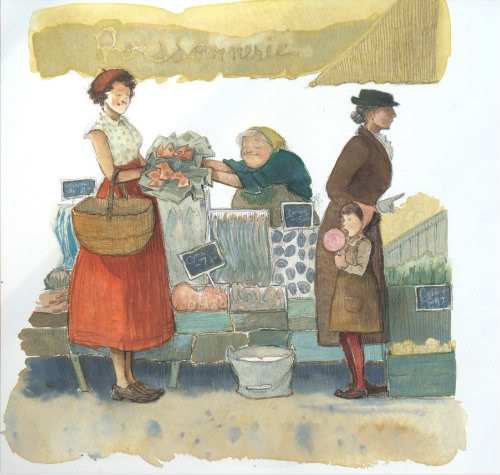
Anything else you’d like to add? What was the best part of working on this project?
Susanna: The best part of writing Minette’s Feast was spending time with Julia Child! More specifically, in terms of the writing process, I enjoyed playing with the language—deciding which cooking verbs to use, weaving in the best quotes and French phrases. And the humor, of course. I haven’t written a book before in which I could really express my sense of humor.
Amy: I really felt like I understood Julia’s experience of going to Paris and standing out, but making a place for herself despite that. When I illustrated this book, I was living in Japan and I felt in a very similar position. I am 5ft 10, which is 4 inches shorter than Julia, but tall enough to understand about being tall. I didn’t speak Japanese, but food is such a wonderful way to experience the world.

What’s next for you?
Susanna: Next up is a picture book about John, Paul, George, and Ringo, tentatively titled Fab Four Friends: The Boys Who Became the Beatles.
Amy: I have a book coming out in September called, That’s What I’d Do, written by singer-songwriter Jewel. It’s very poetic and I rarely get the chance to illustrate things that are more interpretive. I had a lot of fun with that.
Please share a favorite Julia recipe with us, with a few details about when and why you first made it, along with an anecdote about a memorable occasion when you served it.
♥ AMY ♥

This is the base for lots of other yummy sauces and dishes such as our favorite “Mac and Cheese” or “Cheese Beans” as we like to call it around here. It might be simple and not so fancy, but Julia said that Louis XIV loved it, so I guess it is good enough for us too.
Sauce Velouté or Sauce Béchamel
2 Tb butter
3 Tb flour
For béchamel: 2 cups milk + 1/4 tsp salt
For velouté: 2 cups stock
salt and white pepper*
Bring the salted milk OR the stock to a boil.
In a saucepan melt the butter over low heat. Blend in the flour, and cook slowly, stirring, until the butter and flour froth together for 2 minutes without coloring. This is now a white roux.
Remove the roux from the heat. As soon as the roux has stopped bubbling, pour in all of the hot liquid at once. Immediately beat vigorously with a wire whip* to blend liquid and roux, gathering in all bits of roux from the inside edges of the pan.
Set saucepan over moderately high heat and stir with the wire whip until the sauce comes to the boil. Boil for 1 minute, stirring.
Remove from heat, and beat in salt and pepper to taste. Sauce is now ready for final flavorings or additions.
~Adapted from Mastering the Art of French Cooking, Volume One by Julia Child, Simone Beck and Louisette Bertholle (Knopf, 1961).
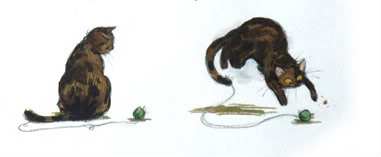
* * *
♥ SUSANNA ♥

As I mentioned, Julia’s Cream of Cucumber Soup is a favorite. I first made it about 30 years ago. It’s thickened with farina (cream of wheat) instead of flour, rice, or potato.
I recently demonstrated how to make it on the Cooking Stage at ALA (the American Library Association Annual Convention). I knew that the other presenters on the Cooking Stage would be professional chefs who’d written new cookbooks, so I challenged myself to do a professional-style cooking demo. Ha!
I made a few test batches, purchased attractive little containers for each ingredient, and memorized facts about cucumbers, shallots, chicken broth, etc., so I could keep up an entertaining banter while I sliced and diced. Did you know that the earliest literary reference to cucumbers is in the Epic of Gilgamesh, from 2500 B.C.? The day before the demo, I shopped for ingredients and cooked enough soup for 75-100 people to sample. My friend’s six-year old daughter was my sous-chef, so now I know a 6-year-old can make the recipe (with a little help). The demo went really well, and the soup was a big hit with the librarians.


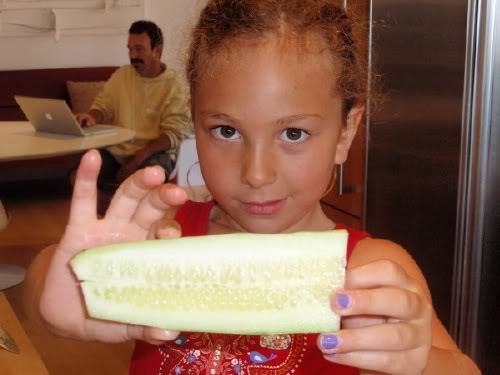

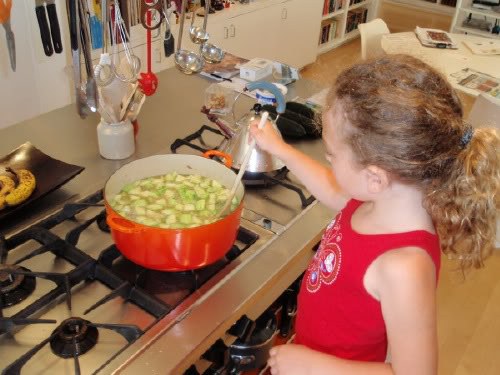
The biggest takeaway for me was how much advance preparation is required to do a cooking demonstration. Now I have just an inkling of how much planning must have gone into each episode of “The French Chef.”

POTAGE AUX CONCOMBRES
(Cream of Cucumber Soup)
for 6-7 cups, serving 4 to 6
1-1/2 lbs. cucumbers (3, about 8″ long)
1/2 cup minced shallots, or a combination of shallots, scallions, and/or onions
3 Tb butter
6 cups liquid: light chicken stock, or canned broth and water
1-1/2 tsp wine vinegar
3/4 tsp dried dill weed or tarragon
4 Tb quick-cooking farina (cream of wheat) breakfast cereal
More liquid if necessary
Salt and white pepper
1 cup sour cream
1 to 2 Tb minced fresh dill, tarragon, or parsley
Peel the cucumbers. Cut 18 to 24 paper-thin slices and reserve in a bowl for later. Cut the rest of the cucumbers into half-inch chunks: you will have about 4-1/2 cups.
Cook the shallots, scallions, or onions slowly in the butter for several minutes until tender but not browned. Add the cucumber chunks, chicken broth, vinegar, and herbs. Bring to the boil, then stir in the farina. Simmer, partially covered, for 20 to 25 minutes. Purée, and return the soup to the pan. Thin out with more liquid if necessary; season carefully with salt and pepper.
Bring in to simmer just before serving, and beat in 1/2 cup sour cream. Ladle into soup bowls, place a dollop of sour cream in each bowl, float slices of cucumber on top of cream, and decorate with a sprinkling of herbs.
For Cold Cucumber Soup:
After stirring in the 1/2 cup sour cream, oversalt slightly and let cool uncovered, stirring occasionally. Then cover and chill. Ladle into chilled soup cups, adding a big spoonful of sour cream to each cup; float cucumber slices on top of the cream and decorate with herbs.
~Adapted from Mastering the Art of French Cooking, Volume Two by Julia Child and Simone Beck (Knopf, 1970).
* * *

MINETTE’S FEAST: The Delicious Story of Julia Child and Her Cat
written by Susanna Reich
illustrated by Amy Bates
published by Abrams BFYR, 2012
Picture Book Biography for ages 3+, 40 pp.
Cool themes: Cooking, cats, Paris, creativity, female role models, French culture
*Includes Afterword, Textual Notes, Bibliography, Glossary and Author’s Note
* * *
***SPECIAL GIVEAWAY!***
To win a brand new copy of Minette’s Feast (includes bookplate signed by the author), simply leave a comment at this post telling us what you like best about Julia Child. Extra entries for blogging, tweeting, FBing, etc. (mention in your comment). Deadline for entries is midnight (EDT) Sunday, August 19, 2012. As before, you may also enter by sending an email with “Minette” in the subject line to: readermail (at) jamakimrattigan (dot) com. U.S. residents only, please. Good Luck!
* * *
♥ ENCORE ♥


* * *
♥ Susanna Reich’s Official Website. Be sure to watch the video where she talks about Minette’s Feast.
♥ Amy Bates’s Official Website and blog. Check out her cool BookPage illustrated bio here.
♥ Minette’s Feast Blog Tour: more interviews with Susanna and Amy, as well as with Abrams Art Director Chad Beckerman and Susanna’s cat Chloe.
♥ Wonderful post at 7-Imp featuring more of Amy’s sublime artwork for Minette’s Feast, including sketches and line drawings.
♥ Susanna’s post at I.N.K.: “Julia Child for Kids: Serious AND Funny”
♥ Don’t miss Susanna’s wonderful tribute to Julia at PBS Food.
* * *
♥ THE LAST MEOW ♥
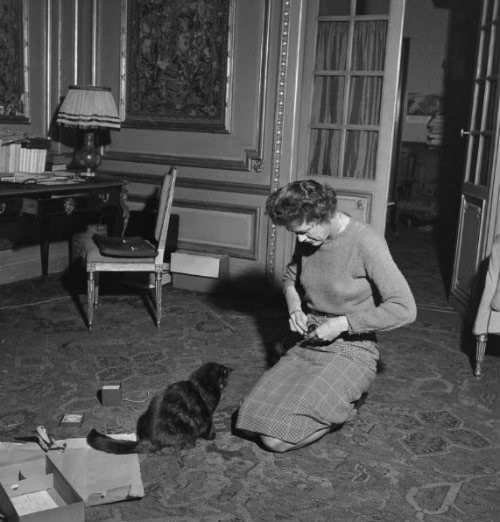
“Minette had spring fever. She bolted out the window onto the roof and made gurgling noises, raced up and down the stairs, leapt into my lap then out again, then sat in the middle of the rug gurgling some more. The vet had informed me that she was not a mutt at all, but a rare type of Spanish cat called le tricolaire, which pleased me no end.” (My Life in France by Julia Child with Alex Prud’homme (Knopf,2006)).
♥ Tomorrow: Jessie Hartland on Bon Appétit: The Delicious Life of Julia Child
——————————————-
*Spreads from Minette’s Feast posted by permission, text copyright © 2012 Susanna Reich, illustrations © 2012 Amy Bates, published by Abrams Books for Young Readers. All rights reserved.
**Thanks to the Schlesinger Library, Radcliffe Institute, Harvard University for permission to post archival photos of Julia in Paris.
Copyright © 2012 Jama Rattigan of Jama’s Alphabet Soup. All rights reserved.

“The illustrations were made from photos that Paul Child took of Julia Child’s hands. So all the hands in the book are Julia’s hands. I like that.”
AAAAHHH! I love that!
Thanks to all three of you for this wonderful interview.
LikeLike
I know, right? When I read Amy’s answer about HANDS, I thought of you!!
LikeLike
Hello. I’ve just found your blog (and subscribed). What I love most about Julia Child is that everything about her was BIG ~ not just her size, but also her love for her husband, for France, for cooking, for learning!
Keep writing…
LikeLike
Hi Kathleen! Yes, you’re right — so big hearted, too. She was truly a national treasure. Thanks for joining us at the table :).
LikeLike
Jama ~ Forget to mention that I found you on Chocolate Chocolate Washington DC’s Facebook page. Aren’t they the treasure, too?! And I found them (CC) via Suzanne Beecher’s DearReader.com. Link to link, friendship to friendship!
LikeLike
What a small world! Ginger and Francie are THE BEST!! Love their shop and their memoir. Must check out DearReader.com, thanks for the tip :).
In case you missed my interview with the Park sisters: https://jamarattigan.com/2011/11/09/doubly-delish-chocolate-chat-with-frances-park-and-ginger-park/
LikeLike
Thank you Jama, Susanna and Amy, this was delicious! What do I like about Julia Child: that she was so friendly to everyone, I guess we might call that accessible today. Her friendliness comes through in the cookbook too. This new book about her is beautiful, nice to think that the younger generation will learn to love her too!
LikeLike
It’s rare to find such consistency about a person’s character/personality, but this is the case with Julia — all accounts I’ve read tout her approachable, friendly manner. She treated everyone the same and acknowledged all, whether a high-ranking chef or dishwasher.
LikeLike
Great Interview! 🙂
LikeLike
Glad you liked it, Erik! 🙂
LikeLike
This is a scrumptious post today, Jama, Susanna and Amy. I love reading how an author and illustrator become attached to the book they are creating together; the entire process is fascinating, really a recipe cooked and served with love to readers. Julia Child was a force of nature, an inspiration to be sure, but her joy in everything for which she cared, going with gusto, makes her a hero. We are all the better for the mark she left on this world.
LikeLike
So well said, Margie — “going with gusto” = YES!! And it *is* lovely to know that both Amy and Susanna felt a strong personal connection to their subject for different reasons.
LikeLike
Fabulous post, Jama! Fabulous book, Susanna & Amy! There’s nothing like waking up in the suburbs of DC and being swept off to 1940s Paris. Thank you!
LikeLike
Mais, oui! I agree — loved being transported there via this beautiful book. Thanks for stopping by, Ginger :).
LikeLike
You know, I look at St. Ju’s stove, and her counters, and everything she worked with, and cringe at the lack of ergonomic care for her. Poor thing, her back must have just been KILLING her sometimes. Everyone’s work spaces were just so short! And yet, she kept smiling, eagerly, breathlessly creating. ♥
LikeLike
Yes, that Paris kitchen was tiny and the stove so low! Luckily in her Massachusetts kitchen they raised the countertop heights to make it more comfortable for her. Love how you call her St. Ju :).
LikeLike
I’ve been wanting to see this book, but haven’t yet.
I love a lot of things about Julia, but I think my favorite is the way she liked to have her things out in the open in her kitchens–pans hung on the walls, utensils on counters. I love that, I guess, because it’s a way I like to live, with my favorite, most-used things nearby where I can get my hands on them easily.
LikeLike
Great answer, Adrienne! And the way they are displayed in her kitchen, they are works of art, tools cherished not only for their utility but their beauty and the memories they evoke. Did you know that Paul designed the kitchen and drew outlines of every pot, pan and utensil on the walls so they’d know exactly where everything belonged? That’s an organized kitchen!
LikeLike
Jama, I love that you asked about favorite spreads, and I loved both answers. I had the same aching back feeling as Tanita looking at that kitchen. Yet she persevered. I loved the joy in this book, though you know I’m a dog-lover — if I’d only known Minette… and it was great to see Susanna’s floral arrangement and whisk, which she mentions in the afterword, but we don’t see. Delicious!
LikeLike
Don’t know how she managed to cook much of anything on that tiny stove, which practically only came up to her knees. Not to mention the lack of counter space. Susanna’s floral creations were beautiful and I’m grateful she agreed to share photos :).
LikeLike
First of all. I’m totally loving this blog! And I think I loved about Julia is what I’m noticing here in the interviews and commentary from all involved…a sheer joie de vive and general interest in people. I loved the cucumber soup recipe although the previous blog post re: Julia’s favorite chocolate cake is calling to me! I’m definitely developing a craving that an Enteman’s chocolate cake will not fix in this particular situation!
LikeLike
I hope you make both the soup and the cake to fully satisfy your cravings and to honor Julia this week. Thanks for reading and commenting!
LikeLike
I admire Julia’s abitlity to not only teach but to make it OK to not do well. That’s a rare thing in a teacher. She was not at all slick, either. Most inspirational was her work ethic. Imagine making recipes over and over and over until they were just right.I feel lucky to do them once, although I’ve made her beef Burgundy many, many times and her French bread more than once. Thanks for capturing so much of the Queen of Cuisine for her 100th birthday!
LikeLike
You’ve made her French Bread recipe? Wow. I bow to you, Elle. Quite a feat!
And you’re absolutely right about her work ethic. She’s made me want to do better in all things, to keep striving for perfection.
LikeLike
You had me at “romantic ambiance of late 40′s Paris” – positively swooning here. The fact that the narrative is written from a pampered, well-loved feline’s perspective is a stroke of genius, I think! What a lovely interview once again, the page spreads leave me ‘salivating’ and wanting more.
I have seen the film Julie and Julia, and what struck me the most was her tenacity to learn and know more about culinary art – despite the fact that it was perceived to be a male-dominated profession, kind of like an old gentleman’s club. I try to show snippets of her life story from the video in my own graduate class whenever we talk about gifted women in male-dominated professions and some of the difficulties she encountered before she attained expertise in the field.
LikeLike
What a great idea to include snippets from the video — Julia is definitely someone who persevered in a very male-dominated profession. She was the only female in her class at Le Cordon Bleu and never hesitated to stand her ground.
Susanna and Amy have truly created a stunning book!
LikeLike
what i love the most about julia child is that she didn’t hide her mistakes. if something went wrong on her tv show, she’d just say mistakes happen, try again.
LikeLike
Yes, I admire that about her too, Valerie. She made it okay for the rest of us to be more fearless, without being so hung up failure. It’s interesting to contrast her “mistakes okay” philosphy with Martha Stewart’s — where every little thing has to be perfect.
LikeLike
oh yes! martha’s view just doesn’t work for me at all. life’s way too messy to try to be perfect all the time. learning from mistakes i can handle.
LikeLike
What I love about Julia? So many…but which to choose?
1. Her fearless way of cooking (so what if the meat fell on the floor? Pick it up, and continue toute suite!). Anyone can do it, with gumption!
2. She referred us to La Super Rica [and it’s awesome, just like she said it was] : http://nyti.ms/PnSZ8O
3. Her graciousness and natural class, even in the face of subtle snark:
LikeLike
Great minds think alike — I’m sharing this classic Letterman video tomorrow :)!
She never got flustered, never worried about making mistakes, it all seemed so natural, going with the flow — but there was a LOT of preparation beforehand, where she probably mentally prepared herself for all the things that could possibly go wrong. Tricks up her sleeve at every turn :).
LikeLike
I like Julia Child for her sense of humor and great cooking skills
Digicats {at} Sbcglobal {dot} Net
LikeLike
Thanks for entering the giveaway!
LikeLike
I shared on Facebook as Carolsue Anderson
Digicats {at} Sbcglobal {dot} Net
LikeLike
Your giveaway is posted on my blog
http://mscarolsue.blogspot.com/2012/01/giveaways-ive-entered.html
Digicats {at} Sbcglobal {dot} Net
LikeLike
Hi, Jama. This book has been on my TBR list for a while, so I was thrilled to find your giveaway. I love how you had the author and illustrator do the interview together. Very great idea, as they know the ins and outs of the book better than anyone. So…my favorite thing about Julia Child? I guess I don’t really know my favorite thing quite yet. But the most interesting to me right now is how tall she and her family were. I didn’t know that!
LikeLike
Yes, the height thing is quite remarkable. I knew she was tall, but not *that* tall! Apparently she told people she was 6’2″, but in reality was closer to 6’4″! Best thing is that she used her height to her advantage — she once remarked that in crowds, she always had access to fresh air :).
LikeLike
And she probably always had the best view, too! That could come in pretty handy!
LikeLike
My favorite Julia Child episode was the one where she didn’t clean her electric hand mixer, but instead simply dropped it into a waiting wastebasket.
LikeLike
Don’t remember that episode! I want to watch them all again :).
LikeLike
I am so late in responding to this AMAZING interview…how inspiring the whole thing was. I can’t wait to get my mitts on a copy. Amy’s sketch from her favorite kitchen scene positively floored me when I first saw it, she so perfectly captures personality in movement and body language, especially the specific brand that was Julia Child’s…ah. Yum. Lovely to hear about Susanna’s inspiration and backstory as well…and the food verbs!
XO
LikeLike
Amy’s work for this book is positively sublime. She should win an award for that spread alone! 🙂
LikeLike